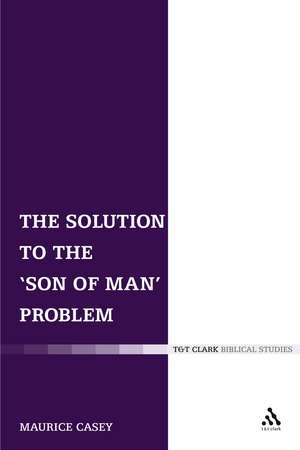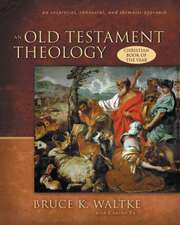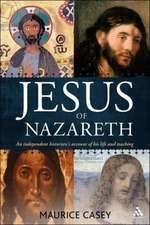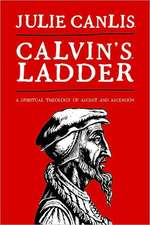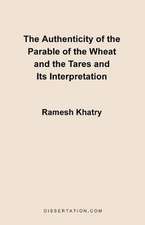The Solution to the 'Son of Man' Problem: The Library of New Testament Studies
Autor Maurice Caseyen Limba Engleză Paperback – 31 aug 2009
Din seria The Library of New Testament Studies
- 34%
 Preț: 509.52 lei
Preț: 509.52 lei - 22%
 Preț: 832.58 lei
Preț: 832.58 lei - 22%
 Preț: 832.09 lei
Preț: 832.09 lei - 24%
 Preț: 190.33 lei
Preț: 190.33 lei - 22%
 Preț: 832.65 lei
Preț: 832.65 lei - 23%
 Preț: 191.31 lei
Preț: 191.31 lei -
 Preț: 221.70 lei
Preț: 221.70 lei -
 Preț: 98.92 lei
Preț: 98.92 lei - 31%
 Preț: 830.87 lei
Preț: 830.87 lei - 22%
 Preț: 834.60 lei
Preț: 834.60 lei - 22%
 Preț: 831.59 lei
Preț: 831.59 lei - 30%
 Preț: 717.05 lei
Preț: 717.05 lei - 22%
 Preț: 835.03 lei
Preț: 835.03 lei - 30%
 Preț: 511.40 lei
Preț: 511.40 lei - 24%
 Preț: 190.33 lei
Preț: 190.33 lei -
 Preț: 158.77 lei
Preț: 158.77 lei - 30%
 Preț: 510.04 lei
Preț: 510.04 lei - 22%
 Preț: 832.99 lei
Preț: 832.99 lei - 30%
 Preț: 509.52 lei
Preț: 509.52 lei - 22%
 Preț: 832.80 lei
Preț: 832.80 lei - 22%
 Preț: 831.76 lei
Preț: 831.76 lei - 22%
 Preț: 834.93 lei
Preț: 834.93 lei - 22%
 Preț: 831.59 lei
Preț: 831.59 lei - 22%
 Preț: 832.41 lei
Preț: 832.41 lei - 22%
 Preț: 832.99 lei
Preț: 832.99 lei -
 Preț: 414.71 lei
Preț: 414.71 lei - 30%
 Preț: 773.65 lei
Preț: 773.65 lei - 22%
 Preț: 834.93 lei
Preț: 834.93 lei - 14%
 Preț: 511.81 lei
Preț: 511.81 lei -
 Preț: 222.16 lei
Preț: 222.16 lei - 30%
 Preț: 775.67 lei
Preț: 775.67 lei - 30%
 Preț: 1012.49 lei
Preț: 1012.49 lei - 30%
 Preț: 509.02 lei
Preț: 509.02 lei - 30%
 Preț: 656.90 lei
Preț: 656.90 lei -
 Preț: 469.92 lei
Preț: 469.92 lei -
 Preț: 471.68 lei
Preț: 471.68 lei -
 Preț: 173.21 lei
Preț: 173.21 lei - 30%
 Preț: 833.64 lei
Preț: 833.64 lei - 22%
 Preț: 834.93 lei
Preț: 834.93 lei - 31%
 Preț: 772.17 lei
Preț: 772.17 lei - 30%
 Preț: 774.20 lei
Preț: 774.20 lei - 14%
 Preț: 1124.92 lei
Preț: 1124.92 lei - 22%
 Preț: 948.51 lei
Preț: 948.51 lei - 14%
 Preț: 1128.84 lei
Preț: 1128.84 lei - 31%
 Preț: 1065.91 lei
Preț: 1065.91 lei - 22%
 Preț: 777.71 lei
Preț: 777.71 lei - 31%
 Preț: 1064.84 lei
Preț: 1064.84 lei - 22%
 Preț: 1063.44 lei
Preț: 1063.44 lei - 22%
 Preț: 889.49 lei
Preț: 889.49 lei - 22%
 Preț: 1006.06 lei
Preț: 1006.06 lei
Preț: 309.31 lei
Preț vechi: 335.23 lei
-8% Nou
Puncte Express: 464
Preț estimativ în valută:
59.19€ • 61.57$ • 48.87£
59.19€ • 61.57$ • 48.87£
Carte tipărită la comandă
Livrare economică 15-29 aprilie
Preluare comenzi: 021 569.72.76
Specificații
ISBN-13: 9780567030702
ISBN-10: 0567030709
Pagini: 384
Dimensiuni: 156 x 234 x 20 mm
Greutate: 0.57 kg
Editura: Bloomsbury Publishing
Colecția T&T Clark
Seria The Library of New Testament Studies
Locul publicării:London, United Kingdom
ISBN-10: 0567030709
Pagini: 384
Dimensiuni: 156 x 234 x 20 mm
Greutate: 0.57 kg
Editura: Bloomsbury Publishing
Colecția T&T Clark
Seria The Library of New Testament Studies
Locul publicării:London, United Kingdom
Caracteristici
Highlights for the first time the importance of careful study of the Aramaic traditions about Jesus.
Cuprins
1. The State of Play
2. The Use of the Aramaic Term 'Son of Man'
3. No Son of Man Concept
4. Six Authentic Sayings
5. The Healing of the Paralytic (Mark 2.1-12)
6. Jackals Have Holes (Matt. 8.19-20//Luke 9.57-8)
7. - The Son of Man in the Heavenly Court (Luke 12.8-9//Matt. 10.32-3; Mark 8.38)
8. Betrayed by a Kiss (Luke 22.48)
9. Jesus Predicts his Death and Resurrection
10. Other Synoptic Sayings
11. Translation and the Use of Scripture: From Sayings of Jesus to the Synoptic Evangelists
12. The Johannine Sayings
13. Conclusions
Endnotes
Bibliography
2. The Use of the Aramaic Term 'Son of Man'
3. No Son of Man Concept
4. Six Authentic Sayings
5. The Healing of the Paralytic (Mark 2.1-12)
6. Jackals Have Holes (Matt. 8.19-20//Luke 9.57-8)
7. - The Son of Man in the Heavenly Court (Luke 12.8-9//Matt. 10.32-3; Mark 8.38)
8. Betrayed by a Kiss (Luke 22.48)
9. Jesus Predicts his Death and Resurrection
10. Other Synoptic Sayings
11. Translation and the Use of Scripture: From Sayings of Jesus to the Synoptic Evangelists
12. The Johannine Sayings
13. Conclusions
Endnotes
Bibliography
Recenzii
'This impressive book brings to fruition Casey's work on the Son of Man problem over many years. It is learned, original and trenchant. It is sure to dominate the field.'
'This book is the most comprehensive and learned work on the notoriously complicated 'son of man' problem and is based on over thirty years of research. In typical fashion Casey demolishes a variety of alternative solutions proposed over the years and is ruthless in exposing faulty methodologies and non-argumentation. It is not only the comprehensive and highly persuasive nature of the work that sets Casey's solution apart from alternatives solutions, but also the rare ability to combine detailed linguistic research in several of the original languages with a variety of interdisciplinary approaches (e.g. identity, cross-cultural healings, translation studies). This book is essential reading for anyone interested in the historical Jesus, the development of early Christology, the canonical gospels, and Aramaic studies. The Son of Man Problem ought to be regarded as a landmark publication on this complex issue.'
'Casey has written a definitive book on a previously unresolved problem ... I am convinced that his solution to the Son of Man problem is successful, even formidable.' April D. DeConick, Religious Studies Review, 2008
Review in International Review of Biblical Studies, vol. 54:2007/08
"In many ways , this is a magnificient achievement. Casey has succeeded in writing an history of the 'son of man' sayings from their origins in the Aramaic of the historical Jesus of therir interpretration in the early churchFathers. He submits a great deal of evidence in support of his case from Aramaic and Syriac sources, and his examination of gospel texts is both detailed and astute." "this book is most certainly worth the read. Fair minded scholars, preachers and teachers who are interested in the truth of the historical Jesus and the truth concerning the nature of Jesus ought to consider the arguments contained in this book" ANVIL Vol.25 No.2 2008
"Casey weighs in on an enduring question regarding the relative divinity and humanity of Jesus. He considers the state of play, the use of the Armaic term Son of Man, six authentic sayings, the healing of the paralytic in Mark 2.1-12, jackals have holes according to Matthew and Luke, the Son of Man in the heavenly court, betrayed by a kiss, Jesus predicts his death and resurrection, other synoptic sayings, the translation and use of scripture from the saying of Jesus to the synoptic evangelists, and the Johannine sayings." -Eithne O'Leyne, BOOK NEWS, Inc.
"Casey tackles this most intractable of problems in the interpretation of the New Testament with characteristic attention to detail." "In many ways, this is a magnificent achievement. Casey has succeeded in writing a history of the 'son of man' sayings from their origins in the Aramaic of the historical Jesus to their interpretation in the early church Fathers." "When Casey states that he has proposed 'a complete solution to the son of man problem', he does not exaggerate." "It is a powerful contribution to the debates concerning the person and ministry of the historical Jesus, and indeed to the development of early Christology."
[The Solution to the 'Son of Man' Problem]is useful for students and non-specialists in that it briefly summarizes earlier notions and research concerning the 'Son of Man' question and gives detailed examples in Greek and Aramaic that serve to support the circumlocutional hypothesis that Casey and others support.
'This book is the most comprehensive and learned work on the notoriously complicated 'son of man' problem and is based on over thirty years of research. In typical fashion Casey demolishes a variety of alternative solutions proposed over the years and is ruthless in exposing faulty methodologies and non-argumentation. It is not only the comprehensive and highly persuasive nature of the work that sets Casey's solution apart from alternatives solutions, but also the rare ability to combine detailed linguistic research in several of the original languages with a variety of interdisciplinary approaches (e.g. identity, cross-cultural healings, translation studies). This book is essential reading for anyone interested in the historical Jesus, the development of early Christology, the canonical gospels, and Aramaic studies. The Son of Man Problem ought to be regarded as a landmark publication on this complex issue.'
'Casey has written a definitive book on a previously unresolved problem ... I am convinced that his solution to the Son of Man problem is successful, even formidable.' April D. DeConick, Religious Studies Review, 2008
Review in International Review of Biblical Studies, vol. 54:2007/08
"In many ways , this is a magnificient achievement. Casey has succeeded in writing an history of the 'son of man' sayings from their origins in the Aramaic of the historical Jesus of therir interpretration in the early churchFathers. He submits a great deal of evidence in support of his case from Aramaic and Syriac sources, and his examination of gospel texts is both detailed and astute." "this book is most certainly worth the read. Fair minded scholars, preachers and teachers who are interested in the truth of the historical Jesus and the truth concerning the nature of Jesus ought to consider the arguments contained in this book" ANVIL Vol.25 No.2 2008
"Casey weighs in on an enduring question regarding the relative divinity and humanity of Jesus. He considers the state of play, the use of the Armaic term Son of Man, six authentic sayings, the healing of the paralytic in Mark 2.1-12, jackals have holes according to Matthew and Luke, the Son of Man in the heavenly court, betrayed by a kiss, Jesus predicts his death and resurrection, other synoptic sayings, the translation and use of scripture from the saying of Jesus to the synoptic evangelists, and the Johannine sayings." -Eithne O'Leyne, BOOK NEWS, Inc.
"Casey tackles this most intractable of problems in the interpretation of the New Testament with characteristic attention to detail." "In many ways, this is a magnificent achievement. Casey has succeeded in writing a history of the 'son of man' sayings from their origins in the Aramaic of the historical Jesus to their interpretation in the early church Fathers." "When Casey states that he has proposed 'a complete solution to the son of man problem', he does not exaggerate." "It is a powerful contribution to the debates concerning the person and ministry of the historical Jesus, and indeed to the development of early Christology."
[The Solution to the 'Son of Man' Problem]is useful for students and non-specialists in that it briefly summarizes earlier notions and research concerning the 'Son of Man' question and gives detailed examples in Greek and Aramaic that serve to support the circumlocutional hypothesis that Casey and others support.
